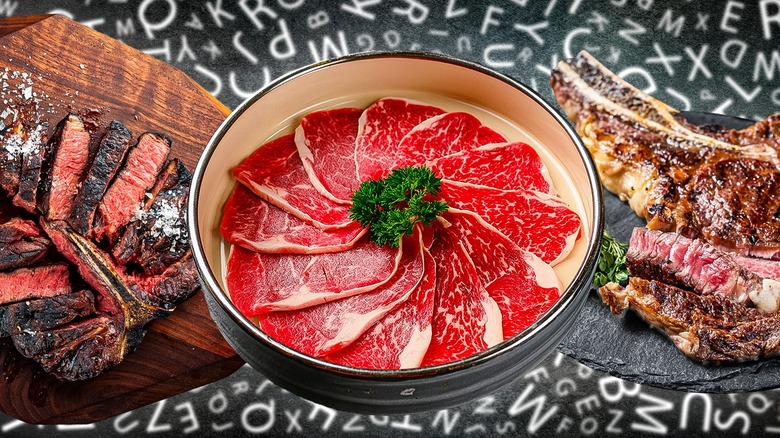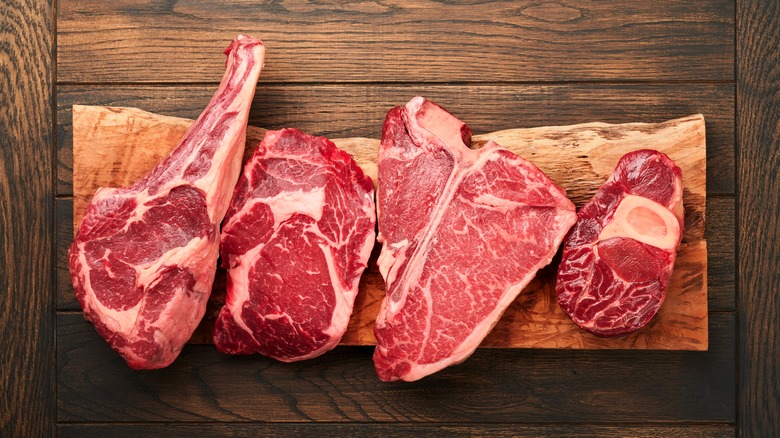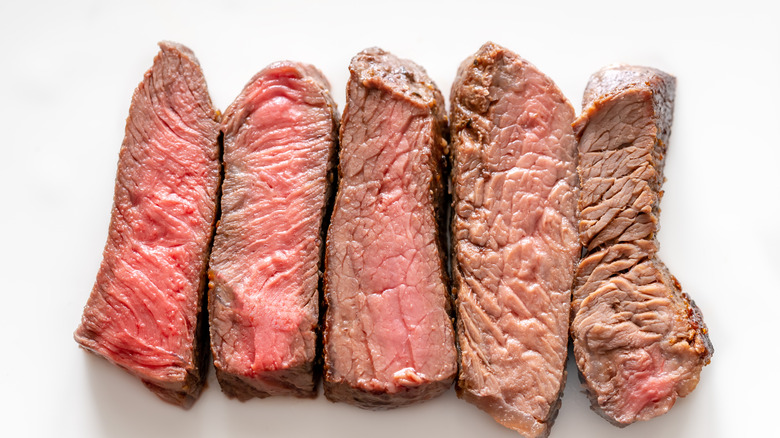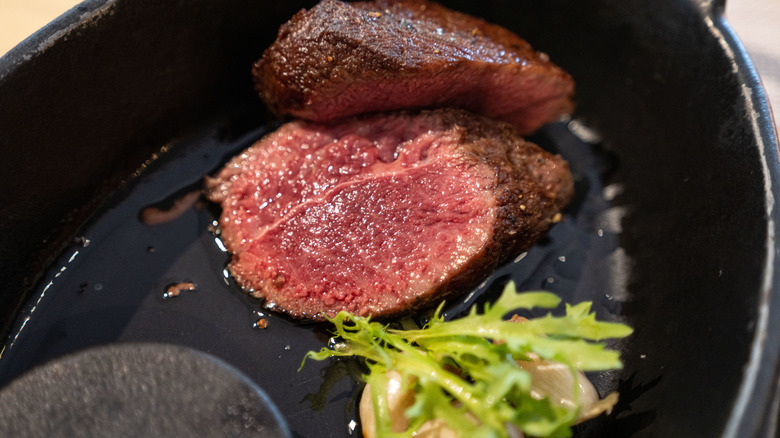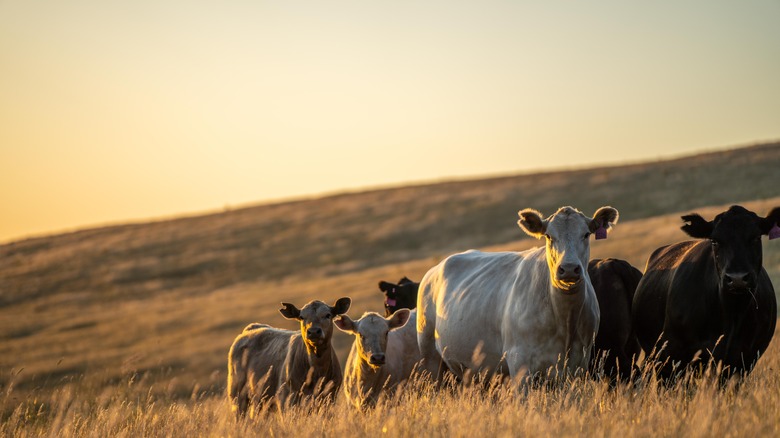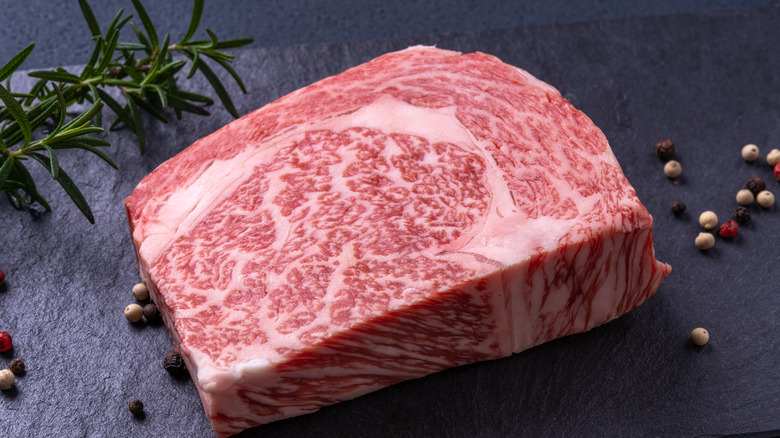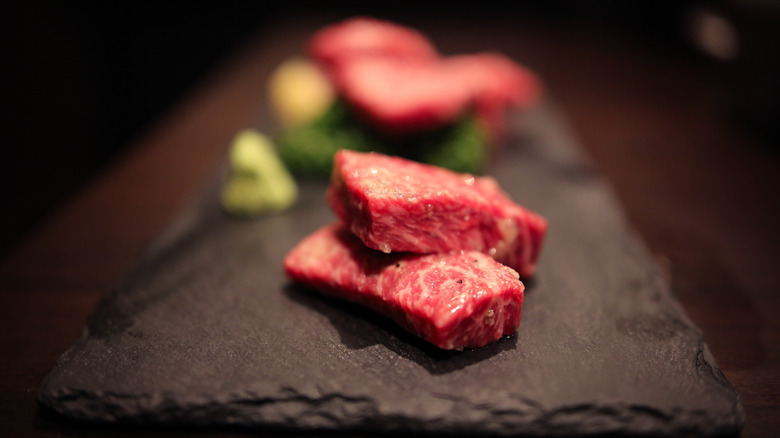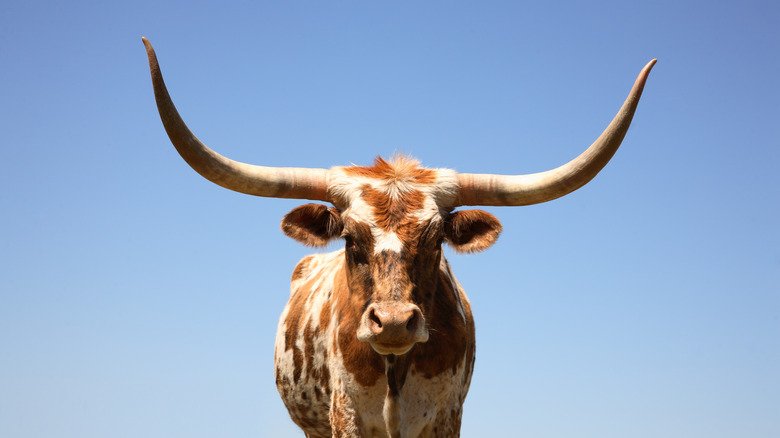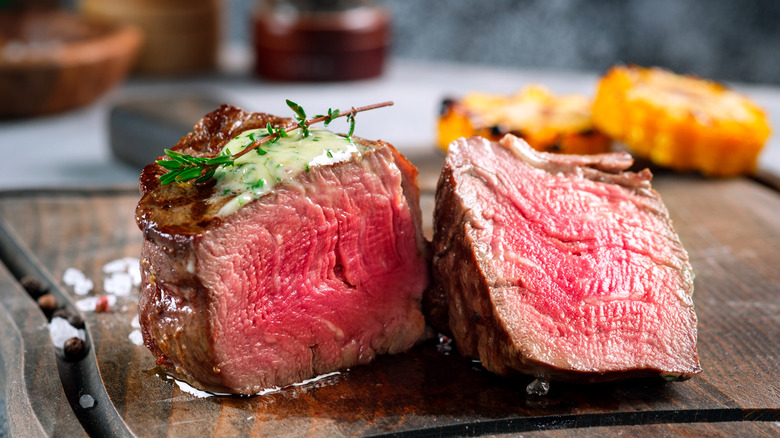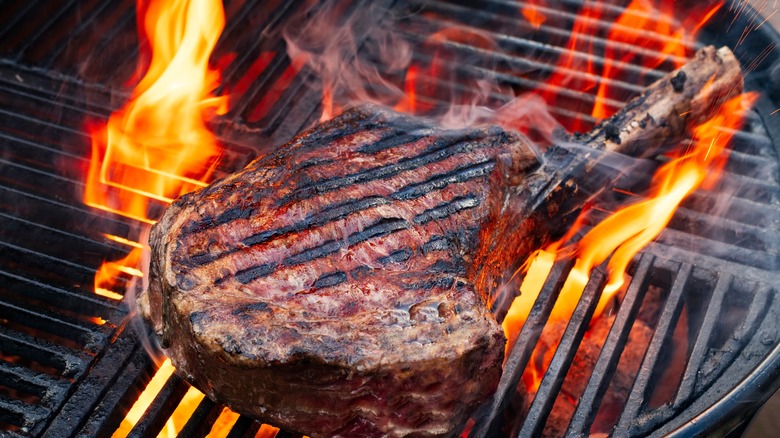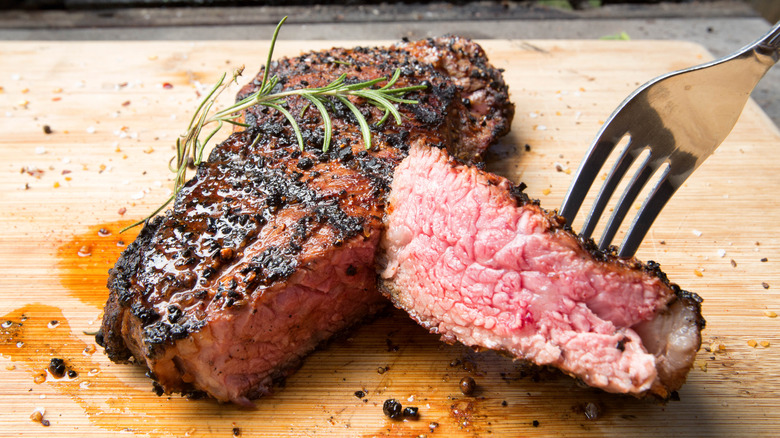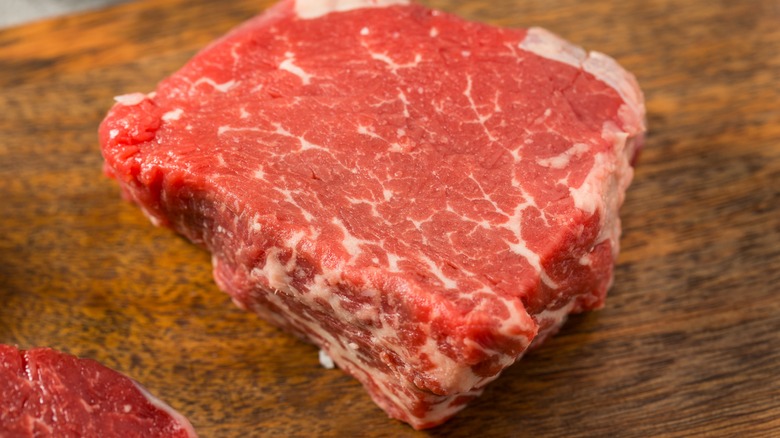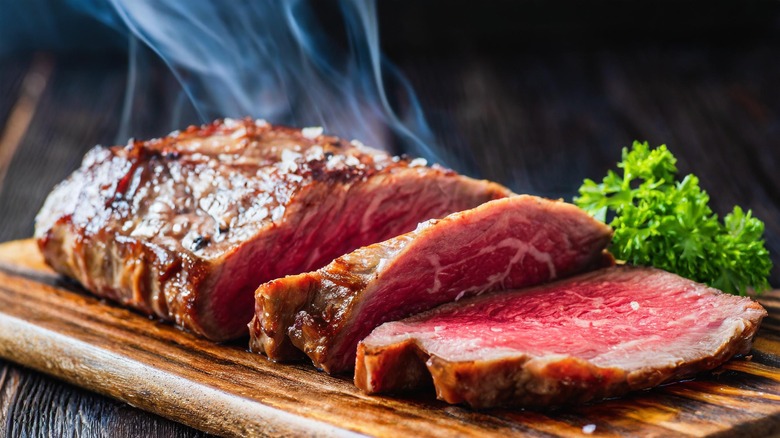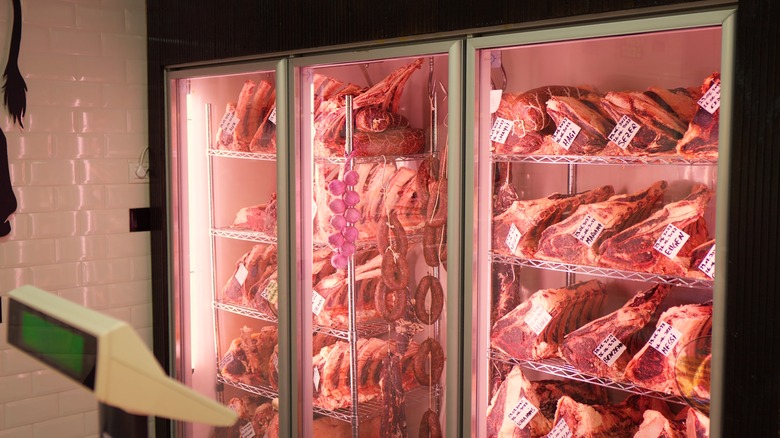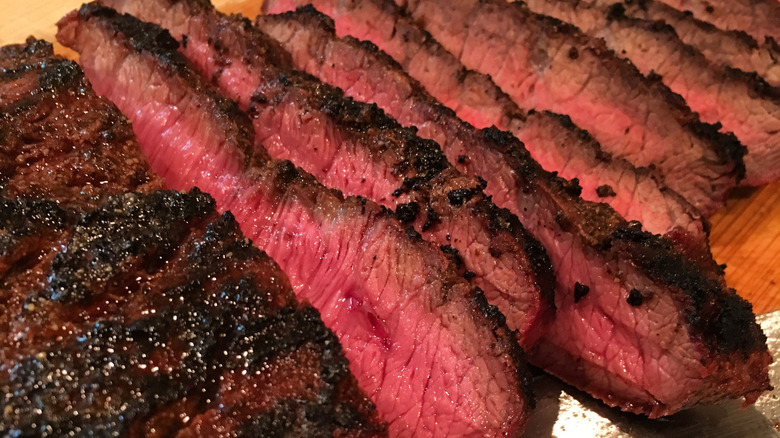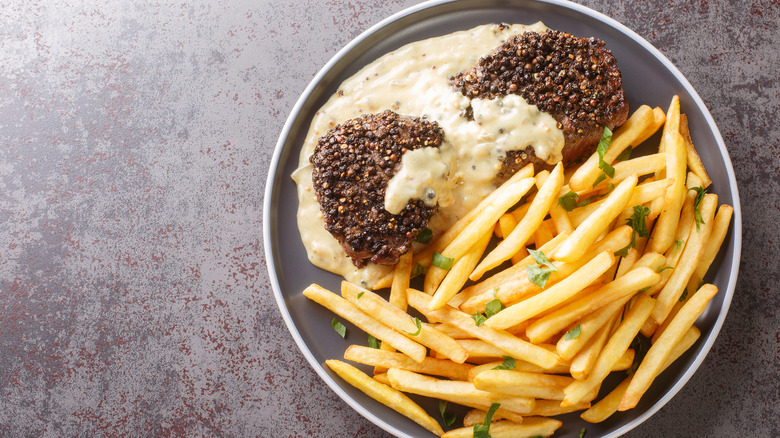The Most Common Steakhouse Menu Terms, Explained By Pros
Navigating a steakhouse menu can be like trying to read another language. From temperatures to accoutrements, there's a whole world of choices to make, and given the expanse of the offerings, it's important you get things right.
According to experts who spoke exclusively to Mashed, transparency can be a major issue on steakhouse menus, which may boast a plethora of terms that "might seem impressive but are relatively empty in terms of providing real information about the quality or preparation of the food," explains Kylian Goussot, executive chef of Lafayette Steakhouse. For him, these terms can include the words "natural," "gourmet," or even "chef's choice," the latter of which he says "is highly subjective and doesn't guarantee quality. It simply means that the chef has selected a particular cut or preparation style, which can be based on personal preference, availability, or other factors unrelated to the quality of the meat." To these "empty" terms, Katie Flannery of Flannery Beef adds "hand-picked" and even "aged," the latter of which she says can be "misleading," given the differences between wet and dry aging.
It's for this reason that Matt Kreider, executive chef of Steak 954, says "specificity means more than anything else." He counsels diners not to be shy about asking questions, saying "We are in the business of teaching our guests, because we love what we do and want to create more food nerds!" If food nerdom is your goal, check out our list of essential, expert-curated vocab you'll find on steakhouse menus.
Prime
If you guessed that the term "Prime" has something to do with quality, you're right. "On a steakhouse menu, 'Prime' refers to a USDA grading of beef," explains Goussot. Prime, unlike Choice or Select beef, "indicates the highest quality, with abundant marbling that contributes to tenderness, juiciness, and flavor," he says. Standard and Commercial grades, which fall below these three major grades, are more often "sold as ungraded or store brand meat," according to the USDA.
According to Kreider, this grading is mainly focused around the amount of marbling consumers should expect to find in the steak. "There are other standards that go into it such as size of cattle," he explains. "But marbling is the key." The crème de la crème, Prime beef is also the rarest grade. According to Chef Michael Vignola, Director of Culinary at Catch Hospitality Group, "Prime makes up roughly 4-6% of all cattle in America." As for what this means on a steakhouse menu, consumers can assume the steak is "rich in marbling, rosy red in color, and unctuous in the mouthfeel," says Vignola.
Cuisson
Cuisson is a French term that literally translates to "cooking," but if you see it on a steakhouse menu, it refers to your preferred cooking temperature. Don't worry: No one is asking you to give the exact temperature of the inside of your steak, but rather to offer an idea of how much pink you'd like to see inside. In other words, this is your answer to the question: "And how would you like that cooked?" Rare steak is typically red and still cool inside; medium-rare is red but warmed through. Medium will be pink and juicy, with a ring of lighter pink around the edges, and medium-well steak is going to be hot all the way through and just slightly pink inside. Well-done, meanwhile, will be completely cooked to the core.
While the temperature you choose is really a matter of personal preference, medium-rare is the most frequently recommended temperature for steakhouse pros — especially when it comes to fattier cuts like ribeye, according to Flannery. "You need enough heat to render the fat and make it enjoyable," she says. "Rare fat just doesn't do it for me." The leaner a steak is, the rarer you'll likely want it to be, for optimal juiciness and tenderness. "These cuts will get exponentially more tough the more they are cooked," says Flannery.
Blue
For those who prefer their steak even rarer than rare, consider ordering it "blue." Also known as "very rare," according to Goussot, or "black and blue," according to Vignola, this temperature sees the steak seared hard on the outside and "extremely rare and cool on the inside," explains Goussot. "It is different from a rare steak, which is more evenly warmed throughout but still red in the center."
For Chef Tolu Eros of Ilé, a contemporary West African restaurant in Los Angeles, blue steak is one of the quickest to prepare. "The steak is seared on the outside for a very short period, typically just 1 minute on each side, ensuring a browned exterior while the inside remains cool and raw," he explains. It's a method that, according to Kreider, "was derived from the old steel workers. They would use a torch or a foundry and sear the outside of the steak, but the inside would be ice cold." The resulting steak, according to Eros, boasts a very distinct texture: "almost raw, very soft and spongy to the touch."
If this description gives you pause, you're not alone. "A blue steak is very good, but definitely not for everyone," says Vignola. Those who prefer their steak blue often do so thanks to its "strong, unaltered beef flavor," according to Eros.
Angus
Angus refers to a breed of cattle with roots in Scotland. The resulting cross-breed, Vignola explains, is "prized for its very consistent genetics." This means that when you see Angus on a menu, you can be almost positive you'll be enjoying the "marbling, tenderness, and flavor" for which Angus is so prized, says Goussot. "The Angus breed tends to produce beef with better marbling than some other breeds, which enhances taste and juiciness," he adds. It's no surprise that Angus is the most popular beef cattle breed in the U.S.
But for Flannery, the word Angus alone isn't enough to designate a steak as being of top quality. "Pay more attention to the grade of the steak (ie: USDA Prime, USDA choice) versus the breed," she says. "Even though Angus is a great beef breed, like everything in life, there are outliers." Luckily, there's a certification program in place to protect its quality. Certified Angus Beef (or CAB) programs "have additional grading scales to further the USDA grade," says Kreider. "There are 10 qualities that CAB programs look for and use additionally. Only 3% of prime beef is considered prime CAB."
Wagyu
Wagyu is yet another prized cattle breed, this time hailing, not from Scotland, but from Japan. Even more marbled than Angus, Wagyu "refers to a group of Japanese cattle breeds renowned for their exceptional marbling and tenderness," according to Goussot. The resulting beef is almost pink in color when raw, due to the prevalence of marbling, and ultra-rich and fatty when cooked.
Despite its Japanese origins, "Wagyu can be domestic or really from anywhere, with any type of crossed genetics," explains Kreider. "It just must have some Japanese Wagyu in its lineage." And as with other terms, not all Wagyu beef is the same. Among the many offerings, "Japanese A5 Wagyu tends to be the gold standard among all Wagyu strains," explains Brad Johnson, the CEO of Verde Farms.
Wagyu beef is graded according to its marbling, on a scale from 3 to 12. "A BMS (Beef Marbling Score) 6 would probably be on par with USDA Prime," says Flannery, "and scores above that would be even more flavorful/tender. What you want to avoid is paying top dollar for a steak that has the Wagyu name, but presents no better than a USDA Choice or Prime."
Kobe beef
Kobe and Wagyu are often confused on steakhouse menus, which makes sense. While they often intersect, Wagyu refers to a breed, which can be raised pretty much anywhere in the world. Kobe, meanwhile, refers to an origin: a specific type of Wagyu hailing from the Japanese region of Kobe. "All Kobe is Wagyu, but not all Wagyu is Kobe," explains Vignola, who dubs it "the champagne of Japanese Wagyu."
To be dubbed Kobe beef, Wagyu cattle must be "born, raised, and harvested in Hyogo prefecture in Japan," explains Kreider, "and its lineage and genealogy are closely monitored. Every restaurant that sells Kobe beef must be registered and authorized to do so. No, that 'Kobe' hot dog for $24 is not real."
When ordering Wagyu beef in a restaurant, Goussot recommends diners "ask about the source, breed, and certification to ensure authenticity," he explains. The very best, our experts agree, is Japanese A5 Kobe beef, which, Johnson says, "gives you that iconic, extreme marbling presentation." And you won't find it just anywhere. Catch Hospitality's steak restaurant "has a specific licensing number for the Kobe that we sell, as we are one of only a handful of restaurants licensed and certified to sell official A5 Kobe beef," says Vignola. According to Business Insider, there were 43 restaurants across the U.S. certified to sell real Kobe beef as of 2016.
Heritage
Another word you may find on a steakhouse menu is "heritage," a term that, like "heirloom" for tomatoes, "refers to traditional breeds of cattle that are raised using historical farming methods," explains Goussot. "These breeds often have distinct flavors and qualities." But while the term "heirloom" is unregulated, The Livestock Conservancy protects the term "heritage" as it pertains to cattle. Anyone using the word must be able to prove that the cow hails from a purebred, endangered breed with a long history in the U.S., dating back to 1925 or earlier.
For Kreider, the term as seen on a menu usually describes "one of the older breeds of cattle" that isn't as "commercialized or 'mainstream'" as others. Similarly, for Vignola, this term means "you can trace the genetics of the cattle to a specific farm to know it's not being pumped full of growth hormones. It is a buzz word to indicate traceability." As examples of these breeds, Johnson cites not just Angus, but also Texas Longhorn, known not just for their characteristic horns but for excellent marbling and flavor.
Filet mignon
Steakhouses should have anywhere between eight to 10 different steaks on the menu if you believe Michelin-starred chef Gordon Ramsay. And with a range of cuts boasting a range of different flavors, it's essential you know the differences. Filet mignon is likely to be the most expensive offering on any steakhouse menu, due as much to its unparalleled tenderness as to its rarity. There are just two small filet mignon steaks on each cow, found at the end of the aptly-named tenderloin.
What filet mignon boasts in tenderness, it lacks in fat. "The filet is a great option for a lean cut that is still amazingly tender," says Flannery. It's for this reason that filet mignon is so often paired with a rich sauce or compound butter. The resulting dishes, with their ultra-tender chew and rich, luxurious sauce, are true elegance on the plate, perfect for pairing with crispy French fries to drag through all of that luscious sauce.
Tomahawk
Ribeye is frequently cited as a steakhouse favorite among experts, thanks to its rich marbling and relative tenderness. And if you like ribeye, you'll love tomahawk. Cut from the same rib section of the cow as the ribeye, it retains not just the rib bone running along the side of the steak, but a protrusion of the bone that makes it look like the tomahawk for which it's named. This doesn't just give the tomahawk steak a unique and distinctive appearance; it also makes it even easier to cook over a live fire, lending it a lovely smokiness.
With about a 2-inch thickness and an average weight of between 30 and 45 ounces, tomahawks are perfect for feeding two hungry diners. Tomahawks also boast a richer flavor than many other steaks, and of course, that length of bone makes them a fairly dramatic offering at steakhouses.
Strip steak
When you see strip steak on the menu, chances are it's a reference to New York strip steak, typically a boneless cut. This cut hails from the short loin of the cow, located behind the ribs, is ultra tender but less marbled, with a great balance between richness and tenderness. Strip steaks in general can either be bone-in or boneless, though Kreider notes that a bone-in strip steak may also be called a Kansas City strip.
Strip steaks can also include the club steak, which Goussot describes as "a smaller cut from the short loin with some bone." Kreider also highlights the T-bone or porterhouse, which is a strip steak that comes with the filet attached, for maximum tenderness. At the end of the day, however, "The strip steak is going to be the same, regardless of name, because it is all derived from the striploin subprimal," Johnson says. Bone or no bone, and regardless of size, it'll boast similar flavor and texture.
Grass-fed
Grass-fed beef has been getting a lot of attention for its health benefits and flavor of late, but there's more to this menu item than meets the eye. At its best, grass-fed steak is a slightly healthier alternative to more typical grain-fed steak, with a lower fat content and more heart-healthy fatty acids (like omega-3 and conjugated linoleic acid), according to a 2010 research review in Nutrition. Grass-fed beef also tends to be more sustainable, though the discrepancies are less pronounced than some research originally seemed to indicate, according to NPR.
Flavor-wise, Vignola explains, grass-fed is more mineral-forward. "You're not going to get that classic unctuous flavor that grain-fed beef gives you," he says. And visually, he notes, "grass-fed beef will also be a lot deeper red with thinner flecks of brighter and whiter fat." According to Kreider, despite an initial surge in popularity, "100% grass fed beef has really dropped off the last handful of years," due in large part to its gaminess, which he compares to the flavor of bison. Still, our experts agree that if you're looking for a leaner steak, grass-fed is a great option.
Grain-fed and grain-finished
Grain-fed beef is far more common in the U.S., and compared to grass-fed, these steaks "will be more of a rosy red color with heavier and thicker marbling," according to Vignola. "It will also eat or finish sweeter than grass-fed beef does."
Feeding cattle corn, however, leads to a bevy of humane, health, and environmental issues, including but not limited to a rise in liver abscesses in cattle, higher greenhouse gas emissions, and fewer omega-3 fatty acids in the resulting beef. It's for this reason that many experts prefer beef from cattle that graze for most of their lives and are "finished" with a diet rich in grains.
"There's a reason we started grain finishing as a culture," says Kreider. "It adds fats and plenty of flavor." Some experts, like Linus Blomqvist, director for conservation, food and agriculture for the California-based Breakthrough Institute, defend this method as the best of both worlds (per NPR).
Dry-aged
Dry-aged beef has also surged in popularity of late, which may be surprising since it's essentially a method of controlled decomposition. But in this case, it paves the way for delicious results: As the beef ages over the course of about a month, the moisture content of the beef is reduced, concentrating its flavors. This, combined with chemical changes to the beef as it ages, results in steaks with a more intense beefy flavor and a tenderer texture. "Dry aged product will have a more intense/deep flavor than unaged steaks," according to Flannery.
Many modern steakhouses dry-age on site, and this is always a great indicator of quality and control over this process. As always, specificity matters here: Steakhouses that tell you how long they age or how they age beef are likely to be doing the actual work required to reap the (more expensive) benefits of true dry-aged steak. A simple indication of "aged" could mean either wet-aged or dry-aged, the latter of which, Flannery says, will produce a far more flavorful finished product.
Blackened
While it could be easy to confuse black-and-blue with blackened, these terms couldn't be more different. Unlike "blue," which refers to a cooking temperature, "blackened" refers to a flavor profile. Blackened beef is seasoned with blackening spices, a blend that usually combines smoked paprika, garlic powder, onion powder, black pepper, oregano, coarse salt, thyme, and cayenne pepper.
This Southern spice blend, popularized by New Orleans chef Paul Prudhomme, adds loads of flavor to steak, though you'll also find it used with chicken and seafood. That said, when it comes to top-quality steaks, a simple seasoning of salt — and maybe a touch of pepper — is all you really need, so think long and hard before opting to order your steak blackened. The tasty combo may punch up the flavor of a ho-hum cut, but it would be a shame to pair it with an exquisite A5 Wagyu filet mignon.
Au poivre
In addition to the steaks themselves, many steakhouse menus are likely to feature a bevy of sauces, from blue cheese to béarnaise, red wine reduction to rich, caramelized shallot fondue. Of these many sauces, au poivre is a classic — a French sauce whose name evokes the "poivre" or pepper at its base.
To make steak au poivre, the steak itself is first coated in crushed peppercorns. It's then seared in a pan, and while the steak rests, the pan is deglazed with cognac, so that the drippings can be incorporated into the base of the sauce. Heavy cream renders this sauce rich and luxurious, which makes it a no-brainer to pair with tender, relatively lean filet mignon. The fact that French fries are a classic accompaniment for steak au poivre should come as no surprise: These crispy morsels of potato are practically begging to be dragged through any remaining sauce.
